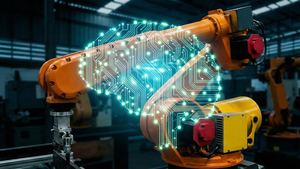
The semiconductor industry is currently undergoing an unprecedented transformation, driven by the insatiable demands of artificial intelligence (AI) and the broader technological landscape. Recent breakthroughs in manufacturing processes, materials science, and strategic collaborations are not merely incremental improvements; they represent a fundamental shift in how chips are designed and produced. These advancements are critical for overcoming the traditional limitations of Moore's Law, enabling the creation of more powerful, energy-efficient, and specialized chips that are indispensable for the next generation of AI models, high-performance computing, and intelligent edge devices. The race to deliver ever-more capable silicon is directly fueling the rapid evolution of AI, promising a future where intelligent systems are ubiquitous and profoundly impactful.
Pushing the Boundaries of Silicon: Technical Innovations Driving AI's Future
The core of this revolution lies in several key technical advancements that are collectively redefining semiconductor manufacturing.
Advanced Packaging Technologies are at the forefront of this innovation. Techniques like chiplets, 2.5D/3D integration, and heterogeneous integration are overcoming the physical limits of monolithic chip design. Instead of fabricating a single, large, and complex chip, manufacturers are now designing smaller, specialized "chiplets" that are then interconnected within a single package. This modular approach allows for unprecedented scalability and flexibility, enabling the integration of diverse components—logic, memory, RF, photonics, and sensors—to create highly optimized processors for specific AI workloads. For instance, MIT engineers have pioneered methods for stacking electronic layers to produce high-performance 3D chips, dramatically increasing transistor density and enhancing AI hardware capabilities by improving communication between layers, reducing latency, and lowering power consumption. This stands in stark contrast to previous approaches where all functionalities had to be squeezed onto a single silicon die, leading to yield issues and design complexities. Initial reactions from the AI research community highlight the immense potential for these technologies to accelerate the training and inference of large, complex AI models by providing superior computational power and data throughput.
Another critical development is High-Numerical Aperture (High-NA) Extreme Ultraviolet (EUV) Lithography. This next-generation lithography technology, with its increased numerical aperture from 0.33 to 0.55, allows for even finer feature sizes and higher resolution, crucial for manufacturing sub-2nm process nodes. Taiwan Semiconductor Manufacturing Company (TSMC) (TWSE: 2330) reportedly received its first High-NA EUV machine (ASML's EXE:5000) in September 2024, targeting integration into its A14 (1.4nm) process node for mass production by 2027. Similarly, Intel Corporation (NASDAQ: INTC) Foundry has completed the assembly of the industry's first commercial High-NA EUV scanner at its R&D site in Oregon, with plans for product proof points on Intel 18A in 2025. This technology is vital for continuing the miniaturization trend, enabling a three times higher density of transistors compared to previous EUV generations. This exponential increase in transistor count is indispensable for the advanced AI chips required for high-performance computing, large language models, and autonomous driving.
Furthermore, Gate-All-Around (GAA) Transistors represent a significant evolution from traditional FinFET technology. In GAA, the gate material fully wraps around all sides of the transistor channel, offering superior electrostatic control, reduced leakage currents, and enhanced power efficiency and performance scaling. Both Samsung Electronics Co., Ltd. (KRX: 005930) and TSMC have begun implementing GAA at the 3nm node, with broader adoption anticipated for future generations. These improvements are critical for developing the next generation of powerful and energy-efficient AI chips, particularly for demanding AI and mobile computing applications where power consumption is a key constraint. The combination of these innovations creates a synergistic effect, pushing the boundaries of what's possible in chip performance and efficiency.
Reshaping the Competitive Landscape: Impact on AI Companies and Tech Giants
These emerging semiconductor technologies are poised to profoundly reshape the competitive landscape for AI companies, tech giants, and startups alike.
Companies at the forefront of AI hardware development, such as NVIDIA Corporation (NASDAQ: NVDA), are direct beneficiaries. NVIDIA's collaboration with Samsung to build an "AI factory," integrating NVIDIA's cuLitho library into Samsung's advanced lithography platform, has yielded a 20x performance improvement in computational lithography. This partnership directly translates to faster and more efficient manufacturing of advanced AI chips, including next-generation High-Bandwidth Memory (HBM) and custom solutions, crucial for the rapid development and deployment of AI technologies. Tech giants with their own chip design divisions, like Intel and Apple Inc. (NASDAQ: AAPL), will also leverage these advancements to create more powerful and customized processors, giving them a competitive edge in their respective markets, from data centers to consumer electronics.
The competitive implications for major AI labs and tech companies are substantial. Those with early access and expertise in utilizing these advanced manufacturing techniques will gain a significant strategic advantage. For instance, the adoption of High-NA EUV and GAA transistors will allow leading foundries like TSMC and Samsung to offer superior process nodes, attracting the most demanding AI chip designers. This could potentially disrupt existing product lines for companies relying on older manufacturing processes, forcing them to either invest heavily in R&D or partner with leading foundries. Startups specializing in AI accelerators or novel chip architectures can leverage these modular chiplet designs to rapidly prototype and deploy specialized hardware without the prohibitive costs associated with monolithic chip development. This democratization of advanced chip design could foster a new wave of innovation in AI hardware, challenging established players.
Furthermore, the integration of AI itself into semiconductor design and manufacturing is creating a virtuous cycle. Companies like Synopsys, Inc. (NASDAQ: SNPS), a leader in electronic design automation (EDA), are collaborating with tech giants such as Microsoft Corporation (NASDAQ: MSFT) to integrate Azure's OpenAI service into tools like Synopsys.ai Copilot. This streamlines chip design processes by automating tasks and optimizing layouts, significantly accelerating time-to-market for complex AI chips and enabling engineers to focus on higher-level innovation. The market positioning for companies that can effectively leverage AI for chip design and manufacturing will be significantly strengthened, allowing them to deliver cutting-edge products faster and more cost-effectively.
Broader Significance: AI's Expanding Horizons and Ethical Considerations
These advancements in semiconductor manufacturing fit squarely into the broader AI landscape, acting as a foundational enabler for current trends and future possibilities. The relentless pursuit of higher computational density and energy efficiency directly addresses the escalating demands of large language models (LLMs), generative AI, and complex autonomous systems. Without these breakthroughs, the sheer scale of modern AI training and inference would be economically unfeasible and environmentally unsustainable. The ability to pack more transistors into smaller, more efficient packages directly translates to more powerful AI models, capable of processing vast datasets and performing increasingly sophisticated tasks.
The impacts extend beyond raw processing power. The rise of neuromorphic computing, inspired by the human brain, and the exploration of new materials like Gallium Nitride (GaN) and Silicon Carbide (SiC) signal a move beyond traditional silicon architectures. Spintronic devices, for example, promise significant power reduction (up to 80% less processor power) and faster switching speeds, potentially enabling truly neuromorphic AI hardware by 2030. These developments could lead to ultra-fast, highly energy-efficient, and specialized AI hardware, expanding the possibilities for AI deployment in power-constrained environments like edge devices and enabling entirely new computing paradigms. This marks a significant comparison to previous AI milestones, where software algorithms often outpaced hardware capabilities; now, hardware innovation is actively driving the next wave of AI breakthroughs.
However, with great power comes potential concerns. The immense cost of developing and deploying these cutting-edge manufacturing technologies, particularly High-NA EUV, raises questions about industry consolidation and accessibility. Only a handful of companies can afford these investments, potentially widening the gap between leading and lagging chip manufacturers. There are also environmental impacts associated with the energy and resource intensity of advanced semiconductor fabrication. Furthermore, the increasing sophistication of AI chips could exacerbate ethical dilemmas related to AI's power, autonomy, and potential for misuse, necessitating robust regulatory frameworks and responsible development practices.
The Road Ahead: Future Developments and Expert Predictions
The trajectory of semiconductor manufacturing indicates a future defined by continued innovation and specialization. In the near term, we can expect a rapid acceleration in the adoption of chiplet architectures, with more companies leveraging heterogeneous integration to create custom-tailored AI accelerators. The industry will also see the widespread implementation of High-NA EUV lithography, enabling the mass production of sub-2nm chips, which will become the bedrock for next-generation data centers and high-performance edge AI devices. Experts predict that by the late 2020s, the focus will increasingly shift towards 3D stacking technologies that integrate logic, memory, and even photonics within a single, highly dense package, further blurring the lines between different chip components.
Long-term developments will likely include the commercialization of novel materials beyond silicon, such as graphene and carbon nanotubes, offering superior electrical and thermal properties. The potential applications and use cases on the horizon are vast, ranging from truly autonomous vehicles with real-time decision-making capabilities to highly personalized AI companions and advanced medical diagnostics. Neuromorphic chips, mimicking the brain's structure, are expected to revolutionize AI in edge and IoT applications, providing unprecedented energy efficiency for on-device inference.
However, significant challenges remain. Scaling manufacturing processes to atomic levels demands ever more precise and costly equipment. Supply chain resilience, particularly given geopolitical tensions, will continue to be a critical concern. The industry also faces the challenge of power consumption, as increasing transistor density must be balanced with energy efficiency to prevent thermal runaway and reduce operational costs for massive AI infrastructure. Experts predict a future where AI itself will play an even greater role in designing and manufacturing the next generation of chips, creating a self-improving loop that accelerates innovation. The convergence of materials science, advanced packaging, and AI-driven design will define the semiconductor landscape for decades to come.
A New Era for Silicon: Unlocking AI's Full Potential
In summary, the current wave of emerging technologies in semiconductor manufacturing—including advanced packaging, High-NA EUV lithography, GAA transistors, and the integration of AI into design and fabrication—represents a pivotal moment in AI history. These developments are not just about making chips smaller or faster; they are fundamentally about enabling the next generation of AI capabilities, from hyper-efficient large language models to ubiquitous intelligent edge devices. The strategic collaborations between industry giants further underscore the complexity and collaborative nature required to push these technological frontiers.
This development's significance in AI history cannot be overstated. It marks a period where hardware innovation is not merely keeping pace with software advancements but is actively driving and enabling new AI paradigms. The ability to produce highly specialized, energy-efficient, and powerful AI chips will unlock unprecedented applications and allow AI to permeate every aspect of society, from healthcare and transportation to entertainment and scientific discovery.
In the coming weeks and months, we should watch for further announcements regarding the deployment of High-NA EUV tools by leading foundries, the continued maturation of chiplet ecosystems, and new partnerships focused on AI-driven chip design. The ongoing advancements in semiconductor manufacturing are not just technical feats; they are the foundational engine powering the artificial intelligence revolution, promising a future of increasingly intelligent and interconnected systems.
This content is intended for informational purposes only and represents analysis of current AI developments.
TokenRing AI delivers enterprise-grade solutions for multi-agent AI workflow orchestration, AI-powered development tools, and seamless remote collaboration platforms.
For more information, visit https://www.tokenring.ai/.






